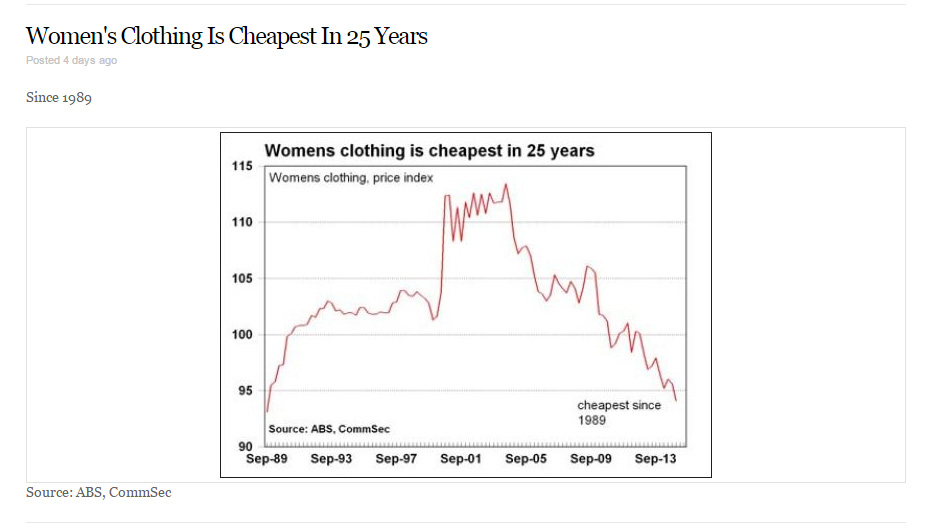 There is a slow coming to consciousness about the exploitation of people, places and planet that our current clothing culture engenders.
There is a slow coming to consciousness about the exploitation of people, places and planet that our current clothing culture engenders.
This revolution in fashion was sparked by a Bangladesh factory collapse two years ago when thousands were killed and injured making cheap clothes for Western bods. April 24 has become Fashion Revolution Day.
While global supply chains are churning out clothing choice for the masses – thoughtful consumers are alive to the fact that quick easy on/off-trend fashion comes with invisible price tags of waste, contamination and human suffering.
Figures crunched by commentator Alan Kohler show women’s clothing is the cheapest in 25 years, fuelling consumption of ephemeral fashion.
 International clothing stores like H&M, Zara, Top Shop and Forever 21 opened in Brisbane in the past year to provide even more high-volume cheap fast fashion to Queensland, Australia. Their arrival, along with online shopping, will be a signature for the 2000s and 2010s.
International clothing stores like H&M, Zara, Top Shop and Forever 21 opened in Brisbane in the past year to provide even more high-volume cheap fast fashion to Queensland, Australia. Their arrival, along with online shopping, will be a signature for the 2000s and 2010s.
Such a far cry from 1940s wartime limitations, when clothing was rationed and expensive, encouraging a Make Do and Mend culture, discouraging excess, glitzy buttons and trims.
This made way for the ‘50s when home-sewing was at its zenith and fashion trends cinched waistlines and circular skirts – followed by bell-bottoms and mini-skirts in the ‘60s.
Come the ‘70s and the emergence of affordable ready-to-wear clothing liberated women from sewing machines and domesticity, and full-time professional work became a reality. Hooray, hurrah.
As work outside home increased, options to save time and effort increased through the ‘80s and ‘90s, and our globalized world now delivers – for our pleasure and amusement – an astounding array of cheap and cheerful choices that are constantly changing.
The rise of cheap fashion in the past 15 years has led to massive consumption and Australians now buy more than 1 billion units of clothing each year – ie 48 units of clothing/person/annum – nearly one per week. We are encouraged to consume, for economic good, for perpetual growth. It makes some people a lot of money. Its costs are insidious.
About 92 percent of clothing is now imported, according to Choice magazine. Very few people sew – that task is largely out of sight and mind, outsourced to factory workers in Asia often working in sweatshop conditions and not earning a living wage.
This reality was ashamedly exposed by the Rana Plaza factory collapse in Bangladesh two years ago when 1133 people lost their lives. Fashion Revolution Day marks that turning point. Things will change over time.
Teaching of home economics in Australia has been eroded in recent decades, and having access or skills to use a sewing machine are relatively rare.
Perhaps we can draw a parallel between cheap fashion and processed food – it is quick and easy but is it good for us and society? Just as we are back in the kitchen making our own food from fresh ingredients because it is good for our health, it may be time to learn a few basic sewing skills for similar reasons.
We don’t need to sew from scratch, we can reuse, restyle and refashion existing textiles – particularly natural-fibre clothing that is worth a second chance. Sustainable, ethical, slow fashion was keynote of the award-winning 365-day Sew it Again project.
FAO figures show only one-third of clothing is natural fibre – down from half just two decades ago. Two-thirds is now made of synthetic fibres, derived from petroleum and coal, which don’t enable the skin to breathe, foster bacterial growth and require more washing to remove odour.
Dr Mark Browne’s 2011 research revealed that with every wash synthetic garments shed 1900 microplastic particles into wastewater, on to shorelines and up the food chain. This is a huge problem that society seems to barely acknowledge in the race to buy more. It’s another of the myriad reasons to be a fashion revolutionary, mindful of our clothing footprint.
- By Jane Milburn, first published in Queensland Country Life’s Smart Farmer magazine.